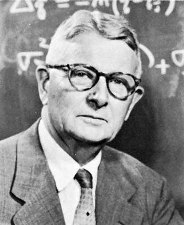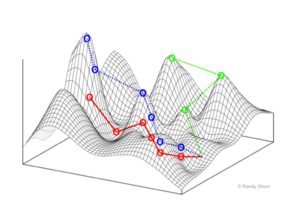Sewall Wright facts for kids
Quick facts for kids
Sewall Wright
|
|
|---|---|

Wright in 1954
|
|
| Born | December 21, 1889 Melrose, Massachusetts, U.S.
|
| Died | March 3, 1988 (aged 98) Madison, Wisconsin, U.S.
|
| Alma mater | Lombard College University of Illinois Harvard University (Sc.D., 1915) |
| Known for | Coefficient of determination Population genetics Causal graph F-statistics Fixation index Fitness landscape Genetic rescue Genetic drift Inbreeding coefficient Path analysis Shifting balance theory Threshold model |
| Awards | Daniel Giraud Elliot Medal (1945) Weldon Memorial Prize (1947) National Medal of Science (1966) Darwin Medal (1980) Thomas Hunt Morgan Medal (1982) Balzan Prize (1984) Foreign Member of the Royal Society (1963) |
| Scientific career | |
| Fields | Genetics |
| Institutions | University of Chicago (1926–1954) University of Wisconsin (1955–1960) |
| Doctoral advisor | William Ernest Castle |
| Other academic advisors | Wilhelmine Key |
| Doctoral students | Edric Lescouflair |
Sewall Green Wright (December 21, 1889 – March 3, 1988) was an American geneticist. He was famous for his important work on how living things change over time, called evolutionary theory. He also worked on something called path analysis.
Wright was one of the main people who started the field of population genetics. This field studies how genes change in groups of living things. He worked alongside other famous scientists like Ronald Fisher and J.B.S. Haldane. Their work helped create the "modern synthesis," which brought together the ideas of genetics and evolution.
He discovered the "inbreeding coefficient," which helps measure how closely related parents are. He used this to study how much inbreeding happens in animal populations due to random changes, called genetic drift. Wright also helped figure out how gene frequencies change in populations. This happens because of things like natural selection, mutation, movement of groups, and genetic drift. He also made big contributions to the study of mammal genetics and how genes work at a chemical level.
Contents
Biography of Sewall Wright
Sewall Wright was born in Melrose, Massachusetts. His parents were Philip Green Wright and Elizabeth Quincy Sewall Wright. Interestingly, his parents were first cousins. This is a fun fact because Wright later studied inbreeding in his science work. When he was three, his family moved to Galesburg, Illinois. His father got a teaching job at Lombard College there.
When he was a child, Wright helped his father and brother. They printed an early book of poems by his father's student, Carl Sandburg. At age seven, in 1897, he wrote his first "book" called Wonders of Nature. He published his last scientific paper in 1988. This means he had one of the longest careers in science writing!
He was the oldest of three very talented brothers. His brothers were Theodore Paul Wright, who was an aeronautical engineer, and Quincy Wright, who was a political scientist. From a young age, Sewall loved mathematics and biology.
Wright went to Galesburg High School and finished in 1906. Then he went to Lombard College, where his father taught. He studied mathematics there. A professor named Wilhelmine Key greatly influenced him. She was one of the first women to get a Ph.D. in biology.
Wright earned his Ph.D. from Harvard University. He worked at the Bussey Institute with William Ernest Castle. Castle was a pioneer in studying mammal genetics. They looked at how coat colors are passed down in mammals.
After college, Wright worked for the United States Department of Agriculture until 1925. Then he joined the Department of Zoology at the University of Chicago. He stayed there until he retired in 1955. After that, he moved to the University of Wisconsin–Madison.
He received many awards during his long career. These included the National Medal of Science in 1966 and the Darwin Medal in 1980. He was also a member of the National Academy of Sciences. For his work on how genes affect evolution, he won the Daniel Giraud Elliot Medal in 1945.
Sewall Wright passed away in Madison, Wisconsin, on March 3, 1988.
Family Life
Wright married Louise Lane Williams in 1921. They had three children: Richard, Robert, and Elizabeth. Sewall Wright was a Unitarian.
Sewall Wright's Scientific Discoveries
Understanding Population Genetics
Wright's studies on inbreeding, how animals choose their mates, and genetic drift made him a key founder of population genetics. He worked with R. A. Fisher and J. B. S. Haldane. Their ideas led to the "modern evolutionary synthesis." This is a big idea that combines genetics with evolution.
Wright invented the "inbreeding coefficient" and "F-statistics." These are important tools used in population genetics today. He also developed the math behind genetic drift. Genetic drift is when gene frequencies in a population change randomly. This happens because of chance events like which individuals are born, which die, and how genes are passed on.
In his work, he also came up with the idea of "effective population size." This helps scientists understand how genetic drift affects different-sized groups. Wright believed that genetic drift working with other forces, like natural selection, was important for how living things adapt.
He described how an organism's traits relate to its ability to survive and reproduce. He called these "fitness surfaces" or "evolutionary landscapes." Imagine a landscape with hills and valleys. The height of the land shows how "fit" a population is. Natural selection would push a population up the nearest hill. But genetic drift could make it wander randomly across the landscape.
Ideas on Evolutionary Change
Wright thought that species might stay the same for a long time because they were at a good "adaptive peak." To evolve to an even better peak, a species might have to go through a "valley" of less successful stages. This could happen through genetic drift if the population was small enough.
If a species was split into many small groups, some of these groups might find higher peaks. If there was some gene flow (genes moving) between these groups, the good adaptations could spread. This idea was called Wright's shifting balance theory of evolution.
Wright had a long debate about this with R. A. Fisher. Fisher thought that most populations in nature were too large for genetic drift to be that important.
Improving Plants and Animals
Wright greatly influenced Jay Lush, who was important in bringing quantitative genetics into animal and plant breeding. From 1915 to 1925, Wright worked for the U.S. Bureau of Animal Husbandry. He studied the inbreeding in livestock breeds used for beef.
He also did experiments with 80,000 guinea pigs to study how genes affect body functions. He analyzed traits of about 40,000 guinea pigs in 23 groups that were bred with brothers and sisters. This work led to his Shifting Balance Theory and the idea of "surfaces of selective value" in 1932.
Wright did a lot of important work on the genetics of guinea pigs. Many of his students became important in the field of mammal genetics. As early as 1917, he understood that genes work by controlling enzymes (special proteins that help chemical reactions). There's a funny story about Wright, though he said it wasn't true. It says that during a lecture, he tucked a guinea pig under his arm, where he usually kept a chalkboard eraser. At the end of the lecture, he supposedly started to erase the board with the guinea pig!
Contributions to Statistics
Sewall Wright is also credited with creating the "coefficient of determination" in statistics. He first published this in 1921. This measurement is often used to check how well a regression analysis works. Regression analysis is a way to find relationships between different pieces of data. It's used in computational statistics and machine learning.
Sewall Wright's Legacy
Wright, Fisher, and Haldane were key people in the "modern synthesis." This was a big step that brought genetics and evolution together. Their work was essential for the contributions of scientists like Dobzhansky, Mayr, and Simpson. The modern synthesis was the most important development in evolutionary biology after Darwin. Wright also had a major impact on the study of mammal genetics and how genes work at a chemical level.
A book called The Book of Why (2018) by Judea Pearl and Dana Mackenzie talks about Wright's work on path analysis. It also discusses how long it took for some scientific fields to accept his ideas.
The software program OpenMx uses a picture of Wright's Piebald Guinea Pig as its symbol.
See also
 In Spanish: Sewall Green Wright para niños
In Spanish: Sewall Green Wright para niños


